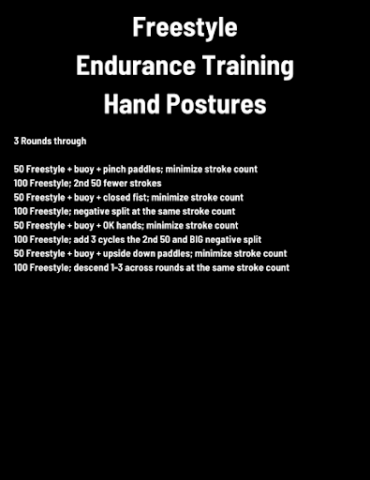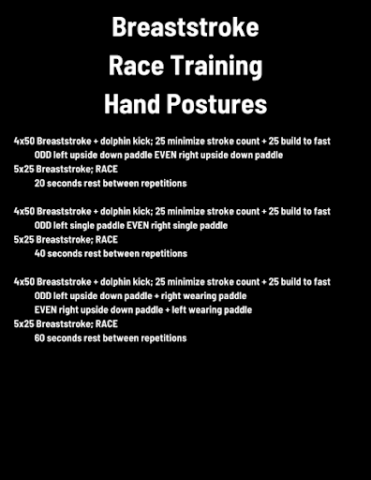Courtesy: Andrew Sheaff
The more propulsion swimmers can create, the faster they will go. The arms are responsible for creating most of the propulsion in backstroke, butterfly, and freestyle, and they’re still hugely important in breaststroke as well. Because they’re so critical for fast swimming, one of the most important goals of any training program is to help swimmers learn to use their arms to create more propulsion.
How do swimmers create more propulsion? They need to move more water backward. How do they move more water backward? They need to use a bigger surface area over a bigger range of motion. Swimmers want to pull in a way that allows as much of their arm to face backward as possible for as long as possible. The bigger the paddle swimmers can use with each stroke, the more propulsion they’re going to create.
How can we help swimmers learn how to use a bigger surface area?
Change their hand posture. It’s a strategy that’s been around for a long time, and it’s a powerful one. But it’s typically used in ways that don’t come close to realizing the potential impact it can create. Let’s look at how to use hand postures in a systematic manner to significantly upgrade swimmers’ propulsive skills.
Why It Works
Changing the size and shape of the hands by assuming different hand postures is effective for two different reasons. First, many swimmers aren’t using their whole arm as well as they could. By closing the hands, they must find alternative ways to create propulsion that don’t rely on their hands. By taking one option away, swimmers are more inclined to use whatever options remain available. In that situation, the obvious choice is to learn to use the forearm more effectively. Once they understand how to use the forearm, they can use the forearm and the hand together when they open the hands back up. More surface area, more speed.
Second, ‘feel’ for the water is all about managing pressure, which is closely tied to creating propulsion. Closed fist swimming can improve swimmers’ sensitivity to the pressure they’re creating on the water. Imagine you’re outside on a sunny day. Now pretend you cover your eyes for two minutes so that no light gets in. When you open your eyes back up after two minutes, you’ll find the same amount of sunlight is suddenly quite intense.
What happened? By taking away a sensory stimulus, you become more sensitive to that stimulus. The same phenomenon occurs with closed-fist swimming: taking away the pressure on the hand makes swimmers more sensitive to the same amount of pressure. Repeat this process often enough and swimmers will improve their ‘feel’ for the water.
Explore Different Options
Swimming with closed fists is a great option, but it’s not the only one. Any change in hand posture where the hand is made smaller is going to have a similar effect. Swimmers can swim using one, two, or three fingers in various combinations. In each case, we’ll get all the benefits described in the previous section. As a bonus, each posture is going to feel slightly different, and it will have a slightly different impact on how swimmers move their hands through the water. More on why this is important shortly.
You can also have swimmers hold different objects in their hands for a similar effect. Holding a golf ball, tennis ball, wiffle ball, or lacrosse ball will all encourage swimmers to use their arms more effectively in slightly different ways. You can also have swimmers hold their paddles upside down or pinch their paddles to reinforce better forearm mechanics. Creativity is the only limitation here.
Use Hand Postures Strategically
With an understanding of the different options available, the next concept to explore is how to use different hand postures for optimal impact. There are two main approaches: variation and contrast. Variation involves rotating between different hand postures. You can rotate by repetition, or you can rotate by rounds of a set. You can use two different postures, or you can use as many as you’d like.
Learning anything occurs through novelty and variation. In most swimming workouts, there is minimal variation and novelty in how swimmers’ hands interact with the water. We can create a ton of both by using different hand postures in the same set. This is particularly effective when swimmers are asked to achieve different performance goals. They must figure out how to perform when their hands are constantly interacting with the water in different ways.
Contrasting different hand postures is perhaps the more powerful option. Here, you can have swimmers use two different strategies at the same time. For example, they can swim with one paddle only, with one fist closed, or with one fist closed and a paddle on the other hand. Now, swimmers will be experiencing very different sensations simultaneously. This creates a much greater awareness of how they’re using their arms to create propulsion, and it provides insight into opportunities to create even more propulsion.
It gets better. Regardless of the stroke, swimmers prefer symmetry, and they’re going to try to make the stroke feel symmetrical. If one hand is ‘smaller’ than the other, it’s going to tend to move through the water faster than the other hand. Swimmers are going to have to figure out how to position the ‘smaller’ arm so that it can hold more water to ‘slow it down’. As an example, swimming with a single paddle is often used to strengthen the paddle arm. The real impact is actually improving the skill of the non-paddle arm because swimmers have to figure out how to hold enough water with the non-paddle arm to match the paddle arm.
Accelerate Learning Through Challenge
Learning and mastering these different postures is great, but that’s just the starting point. Remember that the more propulsion swimmers create, the faster they go, so we want to challenge swimmers to create as much propulsion as possible. Like any skill, we want swimmers to be able to create propulsion at speed and when they get tired. By challenging swimmers when they’re using different hand postures, that all becomes possible.
Add speed to encourage swimmers to learn to create speed with different hands postures. Add stroke counts to encourage swimmers to be more efficient with each stroke. Add stroke rates to challenge swimmers to interact with the water more quickly or more patiently. Add resistance to encourage swimmers to create more force and apply those forces more effectively. Add a pull buoy to prevent swimmers from using the legs to achieve any performance goal. Add fins to help swimmers learn to hold water at faster than race speed. Add hand postures to propulsive drills to make the drills even more effective. Add fatigue to help swimmers learn to make all the above happen when they get tired.
Beyond using these strategies independently, you can combine them to magnify the challenge presented by any one strategy. Swimming with upside-down paddles, a parachute, and a stroke count is going to be a lot more impactful than using any one of those strategies alone. The options are limitless here, and you can challenge swimmers’ skills in many ways.
Smarter Hands, More Propulsion
Coaches have been using closed-fist swimming for decades. It’s a tool that’s stuck around because it works. When we take a great idea and apply it systematically and strategically, the results are even better. It’s one of the best options we have for helping swimmers learn to create more propulsion and improve their feel for the water. Check out the sets below for a few examples of how to put these ideas into practice. They’re performed using different strategies in different contexts with different strokes.
ABOUT ANDREW SHEAFF
Andrew Sheaff has coached swimming for almost 20 years, including 6 years at the University of Virginia where he helped the Cavaliers win 3 NCAA team championships. He is the author of the book ‘A Constraints-Led Approach To Swim Coaching’, which identifies strategies for optimizing individual skill development in large group training environments. The book focuses on enhancing skills that directly improve performance and training those skills to reliably show up in races. He currently works as a consultant to coaches, clubs, and swimming organizations.






